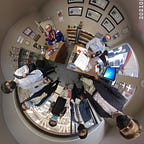The Essence of Care
I’m a research assistant in an endocrinology and metabolism laboratory with an evidently limited representation of women, ethnic minorities, and people from socially disadvantaged populations. My attention grew as I reviewed articles discussing how other laboratories embrace diversity from a range of religions and compatible personalities. For instance, an article by Noam Shomron aims to be diverse by making his laboratory mostly Israeli women and men from different backgrounds in bioinformatics, computer science, and biology, investigating translational medicine. He mentions how some are married, some have children, with prominent differences in their religions, and nevertheless with a shared interest in science (Shomron, 2020). Overall, Shomrom encourages a mixture of cultural backgrounds as it “fosters innovation and scientific breakthroughs.” Individuals such as Shomron explicitly integrate caring practices in their scientific research with the aspiration for more translatable findings. Therefore, in this text, I argue that care plays a critical role within experimental systems as it shapes entanglements within research and obligates political attention to ethics, law, and society in the conduct of science itself. Care signifies an affective state and an ethico-political obligation which is commonly neglected and can shape new formulations for science by addressing standardizations in laboratory contexts and addressing new kinds of scientific uncertainty to enhance understanding.
Firstly, when researchers experience entanglement with the phenomena of a study, it can influence the researcher’s expertise or legitimacy of their research. Therefore, it addresses types of competencies and concerns about whether foregrounding and recurrent science, changes in objectivity when attributing to science, making legitimacy and expertise less credible. Martin et al.’s article discuss the politics of care in technoscience by tying this concept to feminist critiques of science. In the 1960s, theorists observed science surrounding new literature around feminism, presenting many concerns. For instance, a familiar feminist critique is that science and technology studies are masculinized institutions, whereas professional beliefs become more complex, where they become more masculine. Another example was the field of computer science was essentially populated by women and was the main contributor to a more male-dominated domain.
Secondly, Martin et al. introduces the concept of feminist STS, highlighting the projected path in science and technology, to explore dominant genders, privileges, and the politics of care. Martin et al. observes how today “care is a selective mode of attention” as it restricts and cherishes various phenomena while excluding others. Further, she exhibits how “care can render a receiver powerless or otherwise limit their power” showing how care can “organize, classify, and discipline bodies. . becom[ing] a means of governance” (Martin et al., 2015). The perception of care has influenced the formulation of science as a method to reflect on the effects of our own care work and analyze forms of critical care to help researchers pay attention to shifting topologies of power presently. Care and politics have contoured and propelled research into the new formulation of science. However, it’s crucial to recognize the partialities and limits of care that are examined and considered. Even Martin et al. mention how “what we must do is take better care of how we care” (Martin et al., 2015).
Thirdly, when addressing how these translate into the design of scientific institutions, it’s important to find the balance and shared agreement when discussing the amount of care humans should provide. Maria Puig de la Bellacasa’s article examines the significance of implementing care for science and soil and how productivity and efficiency may not always be the solution, but rather move towards care to save our soil. Her takeaway is to encourage more time and effort to be spent on science, although it may not be socially accepted (Bellacasa, 2015). The concept is “soil as a process” which discusses how scientists rethink the scope and boundaries and expertise around particular problems away from assuming who is the initial expert. For instance, in soil science, individuals who believed in “food networks and webs” were labeled as activists. “Activists” were a term to criticize expertise. Therefore, having the expansion of expertise allowed you to consider all matters in care to include them and see how science is developing. The key challenge is the way science is structured in our world and how we can create spaces for care and science. However, care and politics shape scientific institutions by allowing individuals to invest time into other passions and interests without the constraint of time. Another example can be through community spaces where individuals can interact with others and share similar interests to find the balance between end-oriented and pressurized environments.
In conclusion, care revolves around research to shape entanglements and obligate political attention to the conduct of science. It’s an affective state and an ethico-political obligation which can shape new formulations for science by addressing standardizations in laboratory contexts and addressing new kinds of scientific uncertainty to enhance understanding. Recounting the future trajectory, we acknowledge that the perception of making science shapes the fields of medicine, healthcare, and technology. Science will always be perceived under the potential number of opportunities to intervene, produce, or create. Therefore, to strike a balance in the design of scientific institutions means using the power to make the most of the opportunities we can care.
Work Cited
Martin, A., Myers, N., & Viseu, A. (2015). The politics of care in
technoscience. Social studies of science, 45(5), 625–641.
https://doi.org/10.1177/0306312715602073
Puig de la Bellacasa, M. (2015). Making time for soil: Technoscientific
futurity and the pace of care. Social Studies of Science, 45(5), 691–716.
https://doi.org/10.1177/0306312715599851
Shomron, N. (2020, December 17). How I embrace diversity in my lab. Nature
News. Retrieved June
4, 2022, from https://www.nature.com/articles/d41586-020-03606-5
